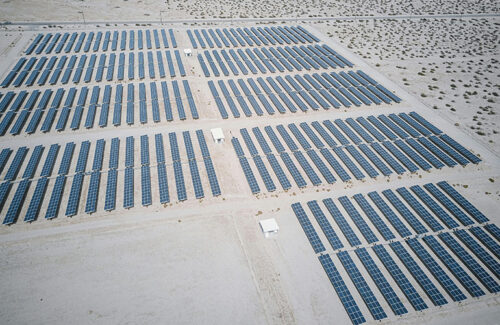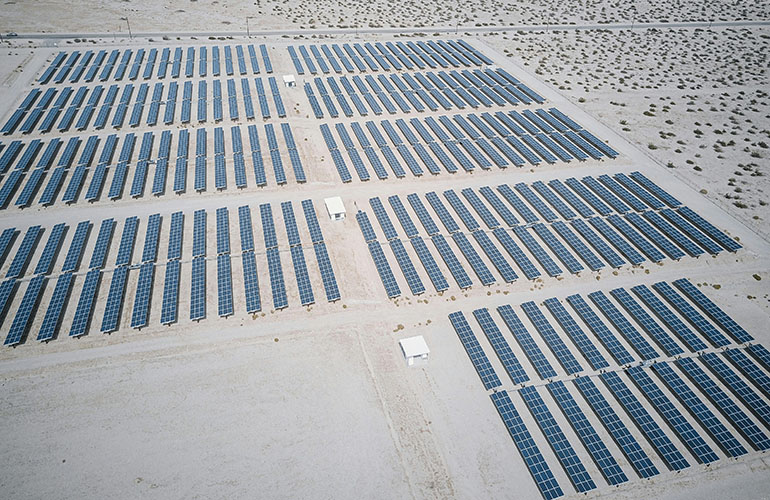Renewable energy sources accounted for more than 90% of new electrical generating capacity added in the United States in 2024 — solar alone accounted for over 81%.
 Specifically for the month of December 2024, renewables were 86.9% of new generating capacity. In its latest monthly “Energy Infrastructure Update” report, FERC says 105 “units” of solar totaling 4,369 MW were placed into service in December along with two units of wind (324 MW) and two units of biomass (45 MW). Natural gas provided the balance: 717 MW.
Specifically for the month of December 2024, renewables were 86.9% of new generating capacity. In its latest monthly “Energy Infrastructure Update” report, FERC says 105 “units” of solar totaling 4,369 MW were placed into service in December along with two units of wind (324 MW) and two units of biomass (45 MW). Natural gas provided the balance: 717 MW.
During the full 2024 calendar year, solar and wind added 30,816 MW and 3,128 MW, respectively. Combined with 213 MW of hydropower, 51 MW of biomass, and 29 MW of geothermal steam, renewables were 90.5% of capacity added for the year. The balance consisted of the 1,100 Vogtle-4 nuclear reactor in Georgia plus 2,428 MW of natural gas, 13 MW of coal, 11 MW of oil, and 28 MW classified as “other.”
Solar accounted for 81.5% of all new generating capacity placed into service in 2024 – 50% more than the solar capacity added in 2023. In December alone, solar comprised 80.1% of all new capacity added. New solar capacity added in 2024 is almost nine-times that added by natural gas and nuclear power combined. Solar has now been the largest source of new generating capacity added each month for 16 months straight: September 2023-December 2024.
Adjusting for the differences in capacity factors among solar, nuclear power and natural gas, the SUN DAY Campaign has determined that the new solar capacity added in 2024 is likely to generate seven-times as much electricity as the new nuclear capacity and about five-times as much as might be expected from the new natural gas capacity.
New wind accounted for much of the balance (8.3%) of capacity additions in 2024, which is more than either the new natural gas capacity (6.4%) or nuclear power capacity (2.9%). Taken together, the installed capacities of just solar (10.2%) and wind (11.7%) now constitute more than one-fifth (21.9%) of the nation’s total available installed utility-scale generating capacity. However, approximately 30% of U.S. solar capacity is in the form of small-scale/DG systems that is not reflected in FERC’s data.
Including that additional solar capacity would bring the share provided by solar and wind closer to one-quarter of the nation’s total. With the inclusion of hydropower (7.7%), biomass (1.1%) and geothermal (0.3%), renewables now claim a 31.0% share of total U.S. utility-scale generating capacity. If small-scale solar capacity is included, renewables are now about one-third of total U.S. generating capacity.
The latest capacity additions have brought solar’s share of total available installed utility-scale generating capacity up to 10.2%, further expanding its lead over nuclear power (7.8%) as well as hydropower (7.7%). Installed utility-scale solar has now moved into fourth place — behind natural gas (43.0%), coal (15.3%) and wind (11.7%) — for its share of generating capacity.
FERC reports that net “high probability” additions of solar between January 2025 and December 2027 total 91,558-MW — an amount almost four-times the forecast net “high probability” additions for wind (23,601 MW), the second fastest growing resource. FERC also foresees growth for hydropower (1,345 MW), geothermal (90 MW), and biomass (61 MW).
Taken together, the net new “high probability” capacity additions by all renewable energy sources would total 116,655 MW with solar comprising over 78% and wind providing another 20%. On the other hand, there is no new nuclear capacity in FERC’s three-year forecast while coal, oil, and natural gas are projected to contract by 23,925 MW, 2,293 MW, and 833 MW, respectively.
If FERC’s current “high probability” additions materialize, by January 1, 2028, solar will account for nearly one-sixth (16.1%) of the nation’s installed utility-scale generating capacity. That would be greater than either coal or wind (both 12.6%) and substantially more than either nuclear power or hydropower (both 7.3%). In fact, assuming current growth rates continue, the installed capacity of utility-scale solar is likely to surpass coal and wind within the next two years, placing solar in second place for installed generating capacity — behind only natural gas.
“For more than a decade, renewable energy sources — led by solar — have dominated growth in U.S. generating capacity,” noted the SUN DAY Campaign’s executive director Ken Bossong. “Consequently, efforts by the Trump Administration to reverse this trend are both illogical and likely to fail.”
News item from SUN DAY

